January 2, 2009
Air Date: January 2, 2009
FULL SHOW
SEGMENTS
Another Dirty Side of Coal
View the page for this story
The dirty side of coal surfaced in Kingston, Tennessee in the form of a toxic black sludge last month. Coal ash, a byproduct of coal combustion, burst out of a Tennessee Valley Authority waste site and spilled out over 300 acres, endangering water supplies and public health. David Freeman, former head of the TVA, helped build the Kingston plant. He tells host Steve Curwood why he thinks coal-burning power plants should be phased out. (06:00)
Climate Change and the New Congress
/ Jeff YoungView the page for this story
Despite the faltering economy, with a new administration and Democrat majority in Congress, the outlook for climate action is hopeful in Washington. Living on Earth’s Jeff Young reports. (05:40)
Why Tropical Forests Fall
/ Ingrid LobetView the page for this story
Tropical forest is disappearing in Africa’s Congo Basin, in Southeast Asia, and in the Amazon. The reasons for the bulldozing and burning of trees vary by region. Living on Earth’s Ingrid Lobet has this primer. (06:00)
Lead and Violent Crime
/ Ashley AhearnView the page for this story
For the past three decades, researchers from the University of Cincinnati have been following 240 people from predominately African American neighborhoods of Cincinnati with high lead contamination. With each passing year, more is revealed about how lead in the environment affects health and behavior. Now, new research reveals that, even at low levels, lead exposure in early development shrinks key areas of the brain, and is linked with violent crime. Living on Earth’s Ashley Ahearn traveled to Cincinnati and has our story. (12:05)
The Good Book’s Green Message
View the page for this story
The bible is the most widely translated book in the world. Now there’s a new edition for environmentalists. In “The Green Bible, all passages that pertain to the earth or the environment are printed in green soy-based ink. Calvin De Witt wrote an essay for the new green good book. He tells host Steve Curwood that the bible says it’s our duty to care for creation. (04:45)
The Old Man and the Storm
View the page for this story
In her new documentary “The Old Man and the Storm,” producer June Cross follows an 82 year old man’s struggle to rebuild his family home in New Orleans after Hurricane Katrina. Cross tells host Steve Curwood about the family’s efforts amidst a myriad of federal, state, city and social obstacles. (07:00)
Melting at the Top of the World
View the page for this story
Global warming is having a dramatic impact in the Himalayas, where the glaciers are melting at a rapid pace. One local mountain climber has started a campaign to educate villagers and trekkers alike about the effects of climate change on the mountains. Dawa Steven Sherpa tells host Steve Curwood about his hopes and fears for the Himalayas. (05:00)
Show Credits and Funders
Show Transcript
Host: Steve Curwood
Guests: June Cross, Calvin DeWitt, S. David Freeman, Dawa Steven Sherpa
Reporters: Ashley Ahearn, Ingrid Lobet, Jeff Young
[[MUSIC: Boards Of Canada “Zoetrope” from “In A Beautiful Place Out In The Country” (Warp Records 2000)]
CURWOOD: From Public Radio International - this is Living on Earth.
ANNOUNCER: Support for Living on Earth comes from the National Science Foundation and Stonyfield Farm.
[MUSIC: Boards Of Canada “Zoetrope” from “In A Beautiful Place Out In The Country” (Warp Records 2000)]
CURWOOD: I’m Steve Curwood.
A billion gallon coal ash spill floods the Tennessee countryside and casts more doubts on plans for clean coal.
FREEMAN: This incident needs to be viewed in the totality of the coal cycle: that Madison Avenue can buy billions of dollars worth of ads and put the words 'clean coal' in the mouth of the president elect and everybody else, but that doesn’t make the stuff clean.
CURWOOD: Plus Africans begin to take some responsibility for climate change and its causes linked to tropical forest destruction.
MAATHAI: Because communities do not have an understanding of how to use land sustainably, prevent soil erosion, when you fly over Africa you see a lot of that slash and burn, especially within the Congo Basin forest.
CURWOOD: These stories and more this week on Living on Earth. Stick Around!
Another Dirty Side of Coal
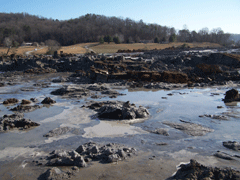
The coal ash sludge oozed over 300 acres in Tennessee. (Photo: Sarah McCoin)
CURWOOD: From the Jennifer and Ted Stanley Studios in Somerville, Massachusetts - this is Living on Earth. I’m Steve Curwood.
Since three days before Christmas we've been learning more and more about the massive spill of toxic coal power plant waste that has made well waters in part of Kingston, Tennessee unsafe to drink. Arsenic and other poisons have now gotten into two nearby rivers.
Local resident Sarah McCoin describes the sludge that’s inundated dozens of homes close to the power plant.
MCCOIN: Charcoal, gray, gooey, nasty, gummy. It looks like the inside of a volcano that has just been active, and it goes as far as the eye can see. The lakes are gone, they're totally consumed.
CURWOOD: The Tennessee Valley Authority, the federal agency that owns and operates the plant, has pledged to clean up the mess but so far there’s no timetable.
And Sarah McCoin still does not feel safe.
MCCOIN: It's a very sick feeling; it certainly brings a tear to your eye. And then obviously I'm worried about my health - my health, my family's health, the health of my friends and neighbors.
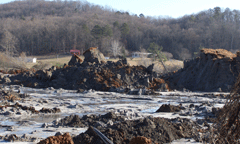
Coal ash, a byproduct of coal burning, contains high levels of heavy metals including arsenic, lead, and cadmium. (Photo: Sarah McCoin)
CURWOOD: Joining us now is the former head of the TVA, S. David Freeman. He was appointed by President Jimmy Carter in 1977, and later ran the Sacramento Municipal Utility District, and the New York Power Authority.
FREEMAN: Let me tell you about this Kingston plant. You’ve happened to have picked a fella that knows a whole lot about it. As a civil engineer for TVA in 1950, I designed the basement floor and the turbine foundations for that power plant. It went online in 1950. You know, the power plants, we thought of as having a twenty-five year life. The thing had lasted for 58 years and gone pretty much full blast the whole time. And the stuff piled up and piled up. If you think of it as water behind a dam, the higher the water gets, the more stress there is on the dam. It – the thing broke down because it obviously was not designed to hold back that much of the stuff. But it’s just a reminder that we are running these old, dirty power plants forever. And it also is a lesson that should be learned about extending the life of these nuclear plants.
CURWOOD: When you were chair of TVA, you closed a number of nuclear power plants …
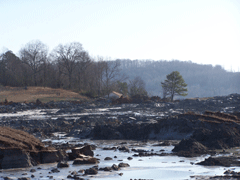
(Photo: Sarah McCoin)
CURWOOD: At that time, how concerned were you that a disaster like this fly ash disaster would happen?
FREEMAN: You know, we were just violating the hell out of the air quality laws, and I’ll have to admit that the back-up of ash was really not on my agenda at the time.
CURWOOD: Now it seemed to me though that there must be some kind of alternative to just dumping the stuff in a big pile. I mean, what alternatives, if any, are there out there?
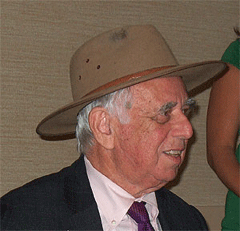
David Freeman, former head of the TVA.
FREEMAN: Well, the best one is to stop burning the coal and shut the plant down and use solar power and wind power. I am not gonna suggest that there is a clean way to control the filthy stuff that’s left over when you burn coal. It’s time that we outlawed new coal-fired plants and start systematically by age, shutting down the old ones. You know, it’s just like with nuclear power. They’ve tried for fifty years and they haven’t figured out what to do with the waste. If we have any morality about ourselves as a civilization, we will stop making waste that we can’t dispose of. You know, this incident needs to be viewed in the totality of the coal cycle, and it’s a reminder that Madison Avenue can buy billions of dollars worth of ads and put the words “clean coal” in the mouth of the president-elect and everybody else, but that doesn’t make the stuff clean.
CURWOOD: It’s well known that coal ash contains high levels of heavy metals such as arsenic and lead, as well as mercury, cadmium, and yet coal ash is regulated like household trash. How logical is that?
FREEMAN: It’s not logical at all. The coal industry has had enormous influence over the EPA, and it’s an outrage that this is continuing, and especially an outrage that the federally-owned Tennessee Valley Authority got away with it. There is a certain religious adherence to low-priced electricity that grew up over the years to where the public power folks felt that anything that would raise the price of electricity was wrong, you know. I was sued by my distributors when I started enforcing the Clean Air Act back then, but they finally gave up. And I used to argue with them that it’s not cheap if it’s at the expense of the environment.

Coal ash, a byproduct of coal burning, contains high levels of heavy metals including arsenic, lead, and cadmium. (Photo: Sarah McCoin)
CURWOOD: Now, Mr. Freeman, what, if anything, does this spill mean for you as somebody who was born in Tennessee?
FREEMAN: Well, it just reminds me of how they have just screwed over my mountains. And I must say that this incident in Tennessee, and I feel sorry for my former friends and neighbors in the Kingston area, and I apologize to them for the extent that I was involved in the beginning, but it is a wake up call that hopefully the whole world will listen to. We have one last clear chance to get off of the fossil fuels and get under renewable energy and we had better take it.
CURWOOD: Mr. Freeman, thanks so very much.
FREEMAN: Well thank you.
CURWOOD: S. David Freeman was head of the Tennessee Valley Authority in the 1970s.
We asked the national mining association for comment. Claiming that coal is the country’s most affordable and plentiful fuel for electric generation they wrote us, “With the economy flat on its back it is irresponsible to use a single incident to denigrate the promise of clean coal technology, or the contributions that coal makes to the economy.”
Related links:
- For more on the case for clean coal, click here
- For in-depth coverage of coal, check out the Living on Earth’s series “Generating Controversy: The Changing Climate of Coal”
- For more on David Freeman, click here
- For more on the Tennessee Valley Authority, check out its website
[MUSIC: Marc Ribot “Fuego” from Party Intellectuals (Pi Records 2008)]
Climate Change and the New Congress
CURWOOD: This New Year brings a new president and new congress to Washington,
and perhaps a new federal approach to global warming. President-elect Barack Obama made climate change a high priority in his campaign. Many of his fellow Democrats in Congress want to act as well, and other nations are waiting for the U.S. to lead the way to an international climate agreement this year. But even though there’s a new lineup in Washington, there are still plenty of nay-sayers on climate change. From Capitol Hill, Living on Earth’s Jeff Young reports.
YOUNG: The depth of a recession is no time to raise energy prices. That’s the argument against a climate change bill, and one we’re sure to hear a lot this year. But don’t tell that to California Democratic Senator Barbara Boxer.
BOXER: The people who say 'oh my God we can’t do anything about global warming because the economy is bad,' they miss the whole point. Because I believe, and I want to reiterate this, combating global warming not just good for economy it’s great. It produces jobs - it makes us stronger. And this is a strong belief I have.
YOUNG: Boxer chairs the Senate’s environment committee and was a lead sponsor of last year’s major climate bill. That bill sought to establish a cap and trade system to harness market forces to control greenhouse gases. But it landed with a thud on the Senate floor amid criticism that it was too expensive and too complicated. Boxer says she learned a lesson from that.
BOXER: The bill got pretty cumbersome at the end of the day. So I think, a simpler bill; it’s going to be greatly streamlined. It is going to be very clear and much simpler than the last bill.
YOUNG: Boxer promises a bill this month that will amend the clean air act to allow the Environmental Protection Agency to set up a cap and trade program for carbon dioxide emissions. She’ll have a strong ally on the other side of Capitol Hill. California Democratic Representative Henry Waxman, a strong proponent of climate action, will take control of the powerful House Energy Committee. Waxman is likely to introduce his own legislation. He favors a cap and trade bill that auctions off all permits, rather than giving them away to major emitters. And Waxman thinks it’s important to set aggressive near term goals to cut greenhouse gases quickly.
WAXMAN: Scientists tell us we have only a short period of time in which to start taking action and reduce these carbon emissions. Otherwise they say that the damage will be irretrievable. It will take on a life of its own and it will not be reversible. We need to act now.
YOUNG: But even with expanded democratic majorities in both houses a climate bill will still face tough opposition based on geography, not party. Both Democrats and Republicans from states with coal, oil and heavy manufacturing are cool to anything that puts their favored fuels at a disadvantage. Senate Energy Committee Chair, New Mexico Democrat Jeff Bingaman, warns against rushing into another ambitious climate change bill right away.
BINGAMAN: Fortunately we don’t have to try to do everything that is worth doing on the subject of global climate change in one gigantic bill.
YOUNG: Bingaman would like to see an energy bill first. He argues that passing a bill with strong investment in renewable energy and technology like carbon capture and storage would make legislation to cap greenhouse gas emissions more palatable. Any energy bill will also have to address some unfinished business from the last Congress -offshore oil drilling. The nearly 40-year moratorium on expanding offshore drilling ended last year amid anxiety over record high gas prices. President-elect Obama says he’s not against an expansion of drilling if it is part of a larger, comprehensive energy strategy.
OBAMA: I’m not thrilled with it simply lapsing as a consequence of inaction without broader thought to how are we gonna achieve energy independence and reduce our dependence on foreign oil and fossil fuels.
YOUNG: The first item on the agenda for the new president and Congress, however, is a massive economic recovery program that could pump 600 billion dollars or more into infrastructure spending. The size and contents are works in progress but many Democrats promise a green approach to economic stimulus. Here’s how House Speaker Nancy Pelosi describes it:
PELOSI: We rebuild our infrastructure to make it green and reduce our dependence on foreign oil, to preserve the planet by stopping global warming. This is what we will have: it will be a forward-looking, an economic recovery package for the future. This is not a 1930's public works project; this is a broadband, modernization of the grid, initiative for the future.
YOUNG: Although Pelosi supports acting on climate change she has not yet made a climate bill a priority for action early in the new Congress. But Eileen Claussen of the Pew Center on Global Climate Change sees hopeful signs.
CLAUSSEN: I think you have to look at energy security, climate change and economic revitalization as one. If we move forward on these issues we will be creating new jobs, we will be rebuilding our economy in a different kind of way. I think that is the way it is being viewed. And that’s why I’m optimistic we will get climate legislation even if times are difficult.
YOUNG: Claussen’s group advocates for an international agreement to fight global warming. She says that won’t happen until the U.S. knows what it’s willing to
do at home.
For Living on Earth I’m Jeff Young in Washington.
Related links:
- Senate Environment Committee Chair Barbara Boxer's plans on global warming:
- House energy Committee Chair Henry Waxman's principles for climate change legislation:
- Obama transition team's energy and environment plans
Why Tropical Forests Fall
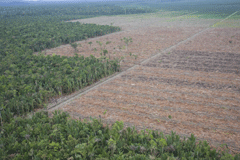
Forests cleared to make way for palm oil plantations in Papua Province, Indonesia. (Photo: Courtesy of Greenpeace Southeast Asia)
CURWOOD: Just ahead – Tropical forests and climate disruption. Keep listening to Living on Earth!
CURWOOD: It’s Living on Earth, I’m Steve Curwood.
Tropical forests cover about seven percent of the Earth, but the widespread cutting and burning of these forests causes some twenty percent of all global warming gas emissions worldwide. So experts in deforestation, rural development, and climate are all working together to make sure that the next international treaty on climate includes measures to slow the destruction and degradation of forests. Living on Earth's Ingrid Lobet takes a look now at the driving forces of tropical deforestation.
LOBET: Even some veteran environmentalists have been startled to realize how much the cutting and burning of tropical forests is responsible for global warming.
MAATHAI: For me, that was amazing.
LOBET: That's Nobel Laureate Wangari Maathai. The tree-planting movement founder spoke at recent climate change talks in Poznan, Poland.
MAATHAI: Because quite often, we in the developing world, we say we are not contributing much to greenhouse gases. But obviously if you take into account deforestation, land degradation, the fact that the majority of people use wood for lighting or cooking, then obviously they are releasing a lot of greenhouse gases into the atmosphere, far more than I'm sure people are aware of.
LOBET: In Africa, Maathai says, it's often villagers who cut the forest to plant crops.
MAATHAI: And because communities do not have an understanding of how to use the land sustainably, prevent soil erosion, when you fly over Africa, you see a lot of that slash and burn, especially within the Congo Basin forest.
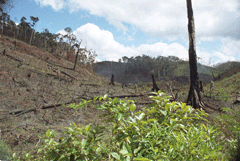
Deforestation. (Photo Jonathan Talbot, World Resources Institute)
LOBET: The Congo Basin forest is second in size only to the Amazon. So preserving it is among the highest priorities of tropical forest experts. Dennis Garrity directs the World Agroforestry Centre or ICRAF, a group with deep tree-planting roots in Africa.
GARRITY: Agriculture is largely responsible for deforestation. And some estimates say that 80 percent of forest conversion is directly related to producing more food.
LOBET: Besides food, another major cause of deforestation in Africa's Congo Basin, says Garrity, is the production of furniture grade wood.
GARRITY: The world is going to have to produce that enormous quantity of wood supply in other ways. Otherwise the sheer demand for wood will swamp any attempts to forestall deforestation.
LOBET: Experts say much of each tall tree cut for furniture wood is left on the ground. On a recent tour of one sustainable timber operation, Wangari Maathai says managers told her their machinery only allowed them to take advantage of 35 percent of the wood they fell.
MAATHAI: The rest is actually taken by local communities and converted into charcoal. That, to me, is just as good as putting the forest on fire.
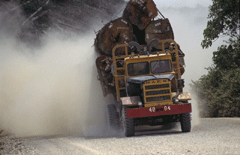
Borneo. (Photo: Claude Barutel)
That's in Africa. But the reasons for deforestation differ sharply across the tropics. Lars Lovold, director of Rainforest Foundation Norway, has worked with indigenous people in forests for 30 years.
LOVOLD: We have all heard from official sources, blaming deforestation on the poor. It is not true. It is the large-scale investments, in oil palms for Asia, in cattle for Central and South America, industrial agriculture taking over from cattle in South America, timber plantations on many continents that really drives deforestation on a large scale.
LOBET: The Brazilian rainforest is being cut largely for two reasons: to graze cattle for beef for domestic and European markets and to grow soybeans for soy oil, soy products and biofuels. Ken Chomitz is senior advisor at the World Bank's Independent Evaluation Group. Like Lovold, he says evidence suggests large-scale players are a big part of the story.
CHOMITZ: Much of the world's tropical deforestation is concentrated in a few areas in the Brazilian frontier and also in Indonesia. And what we know about Brazil suggests that a lot of the clearing in Brazil is done in large chunks: we’re talking a thousand, two thousand acres at a time, which is far too big to be accomplished by anyone but a large industrial interest with bulldozers and machinery.

Forests cleared to make way for palm oil plantations in Papua Province, Indonesia. (Photo: Courtesy of Greenpeace Southeast Asia)
LOBET: In Indonesia, the other major site of tropical tree-razing, the bulldozers are paid for with profits from palm oil, squeezed from the fruit and seeds of the oil palm, grown on plantations.
CHOMITZ: You'll find palm oil in a lot of the processed foods you eat.
LOBET: And in cosmetics, as well. Environmental groups say even people's efforts to make positive changes, for example: avoid transfats… or use biodiesel, are turning forests into palm plantations.
Not only do the reasons for deforestation differ by region, but professionals collaborating on the issue also tend to view it through the lens of their training: as economists, agronomists, environmentalists, and government officials. Here's how Virgilio Viana, former environmental minister for the world's largest tropical forest state, Amazonas, sees it:
VIANA: The most important driver of deforestation in tropical countries is poor governance.
LOBET: Meaning: who owns the forest and who's responsible for protecting it.
And as climate change negotiators prepare for next year's talks in Copenhagen, they'll need to take into account all these reasons for deforestation - if the world hopes to eliminate this fifth of the planet's emissions.
For Living On Earth, I'm Ingrid Lobet.
Related links:
- To learn about reforestation and international climate change negotiations, click here…
- For more on efforts to slow deforestation, click here
- To hear a story about deforestation in Borneo, click here
- For more on how deforestation has affected Haiti, click here
- To learn about the role soy beans play in deforestation in Brazil, click here
[MUSIC: Booker T & The MG’s “Melting Pot” from Melting Pot (Stax Records 1983)]
Lead and Violent Crime

CURWOOD: Lead is a neurotoxin, linked to disorders such as lower IQ and Attention Deficit Hyperactivity Disorder. And now there is more compelling evidence linking lead exposure in the womb and early childhood with violent crime later in life.
These latest findings come from researchers at the University of Cincinnati and Cincinnati Children’s Hospital. For almost three decades they have been following a group of Cincinnati residents – more than 90 percent of them African American. They grew up in neighborhoods with high lead contamination – mostly from the dust of deteriorated lead paint in older apartments and houses.
Living on Earth’s Ashley Ahearn reports.
[SUNDAY MORNING CHURCH SINGING]
AHEARN: It’s Sunday morning and city council member Cecil Thomas is here at Christ Emmanuel Church - where he comes for his weekly dose of hope and renewal. Serving as a police officer for 27 years in Cincinnati, Councilman Thomas watched the violence grow, seemingly without rhyme or reason. The new lead research gives him one potential explanation.
THOMAS: The environment as a totality really pretty much dictates a lot of our problems as relates to crime and things of that nature. Because when you look at areas of our city that are most affected by crime and then you look at buildings that are tainted with lead poisoning paint, then you have to start thinking well maybe there is a link between the effects of lead poising and the overall crime rates, especially in the inner city neighborhoods.
AHEARN: Cecil Thomas knew it was time to make the jump from police work to politics when he started arresting the kids and grandkids of folks he had arrested years before. He says the findings of the Cincinnati Lead Study offer a key avenue to understanding the violence he saw during his time on patrol.
THOMAS: If lead poisoning has a direct impact on the ability to make decisions in a much more rational way, then we are on to something, so to speak. I been a law enforcement officer, some of the times I would say “what’s missing here?” I recall an individual was on his way to the symphony and a young man came up to rob him but it wasn’t enough just to rob him, he then beat him to death with a brick. Now this young man was a product of that environment because he lived down in the Over the Rhine [neighborhood] so you have to ask yourself, ‘well was lead poisoning a factor in this individual committing such a crime?’
[CHURCH SOUNDS]
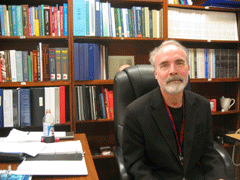
Kim Dietrich, Professor of Environmental Health at the University of Cincinnati, has been working with the lead study participants for almost thirty years, finding correlations between lead exposure and abnormal social behaviors, and now violent crime. (photo: Ashley Ahearn)
AHEARN: Dr. Kim Dietrich and his team at the University of Cincinnati are working to answer just that question. They took the criminal records of the 250 study participants and compared the numbers of violent crimes with the levels of lead each participant had been exposed to throughout his or her life.
DIETRICH: What we found was interesting. The most robust and significant associations were between early exposure to lead and arrests involving violent acts, some sort of violent aggressive behavior.
AHEARN: But they needed the “why”. What might lead be doing, on the physical level, to the brain to cause this violent aggressive behavior?
[MRI SOUNDS]
AHEARN: At Cincinnati Children’s Hospital, Damon’s lying inside the giant white cylinder of the MRI machine as it takes thousands of pictures of his brain.
[MRI SOUNDS]
AHEARN: Damon grew up in Over the Rhine, a neighborhood of downtown Cincinnati where rundown brick buildings line the streets, many of them contaminated with lead paint. He’s been participating in the Cincinnati Lead Study since before he was born. Now he’s 28.

The MRI machine at Cincinnati Children’s Hospital takes thousands of pictures of Damon’s brain to find out what parts are affected by lead exposure.
(photo: Ashley Ahearn)
DAMON: I remember the cab rides, the trips with my mama. It’s just something I been doing since I was a little boy and it continues.
AHEARN: The lead Damon was exposed to may have affected the size of certain parts of his brain – the frontal lobe in particular.
CECIL: The frontal lobe is probably the part that makes us the most human in that it’s executive functioning, attention, inhibition, reasoning, judgment, kind of overall control.
AHEARN: Dr. Kim Cecil is a professor of radiology at the University of Cincinnati and works with Dr. Dietrich. She’s found that children with higher lead levels have smaller frontal lobes as they reach adulthood. She says that may be because lead takes the place of calcium in the brain.
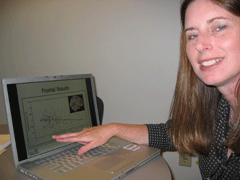
Kim Cecil, Professor of Radiology at the University of Cincinnati shows the correlation between lead exposure and brain volume loss. She says lead acts like calcium in the brain, preventing the maintenance of healthy neurons.(photo: Ashley Ahearn)
CECIL: It interferes with many enzymes that preserve the neurons in the brain so it stops the healthy maintenance of neurons and thus neurons can die. And it looks like a shriveled up brain. So in a way it looks like a person who’s much, much older.
AHEARN: Older - as in closer to senility - not older - as in more mature. Young men, like Damon, show more volume loss to the frontal lobe than young women exposed to similar levels of lead.
But women are by no means exempt from lead’s effects. Like Damon, Laquisha’s been participating in the lead study her whole life. It started with her mom taking her to regular appointments at Cincinnati Children’s Hospital.
[SHAWTY LO HIP HOP IN BACKGROUND]
LAQUISHA: Ma, C’mere.
[TEA CUP STIRRING]
MOM: It wasn’t easy as a matter of fact. I was living Over the Rhine, downtown, in the rehab. It was the paint chippings from the window. They let me know that she had lead poisoning. They did tell me that her lead level was so high they almost had to hospitalize her at one point.
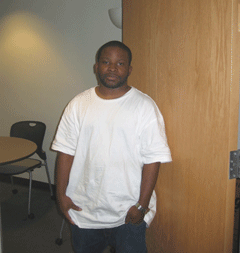
Damon is a participant in the Cincinnati Lead Study, which is linking lead exposure with volume loss in the prefrontal cortex of the brain, especially in men.(photo: Ashley Ahearn)
She been hell on wheels, Ok.
[SHAWTY LO FADES UP]
LAQUISHA: This is Shawty Lo, one of my favorite rappers, cuz he be keepin it real (singing along)
[SHAWTY LO FADES OUT]
LAQUISHA: I wasn’t like the other kids. I won’t catch on as quick as them. Like I can’t concentrate on one thing too long.
I tend, like when stuff doesn’t go my way or whatever, like, sometimes I tend to want to hurt myself or other people. When I couldn’t get my way, I like tear down the whole bedroom, I break mirrors, and everything, I pull all my hair out. And then at the end I be wishin’ I never did it. Like when I went to prison for hitting that police officer, I didn't really mean to hit him, it was just I don’t know.
Me and my old boyfriend, we was downtown at a restaurant, at Arby’s. And he was ordering his food and the same cashier always get his order wrong. So he told her, "Give my money back, I’m tired of you, every time I come here you get my order wrong."
So they was just going back and forth, and the police was in there and when he grabbed me he slapped one handcuff on me and I was goin’ crazy. I was kickin’ screamin’. I wouldn’t let him get the other handcuff on me. So he slammed me and came down with his other knee in my stomach. So I grabbed his belt and the collar of his shirt and I flipped him on his head and I was hitting him with my handcuff that was free and then somehow he got me in a headlock. He was punchin’ me in my head, we was just exchangin’.

Laquisha (center) with co-workers at McDonalds. She has been participating in the Cincinnati Lead Study since she was a year old and says lead exposure has affected her behavior, with some serious consequences. (photo: Ashley Ahearn)
At that point in time I just wasn’t thinkin’. And that got me two years in prison. My first time ever bein’ in trouble. Eighteen. It feel like you ain’t never goin’ nowhere, when your time gonna come.
[INSTRUMENTAL]
MOM: She got a very short temper, very short attention span. Don’t nothin’ hold her interest for too long, nothin’. But I tell you what she can do for hours and hours. She can just sit up and write for hours and hours. She loves to write.
[PAPERS TURNING]
LAQUISHA: I got a lot of stuff that I used to write. And when I wrote this I was in Mary’s View.
MOM: Women’s prison.
LAQUISHA: It’s a women’s prison. I was 20 years, I was probably almost on my way home. I don’t know, I just used to write so many and I didn’t put no dates on them. But this one, it say:
Hey I’m only 20 years old. I’m in prison because I fail to realize how much I love my family and how memories can hurt. I miss bein’ eight years old, when I come home from school the sound of my father’s car pickin’ me up. I miss watching cartoons with my big brother every morning before we go to school. I miss the smell of my cheeks that I used to wipe away when my mom would kiss me. I miss my brother brushin’ my hair when I was little. I miss the knob opening my bedroom when my mom come home from work. There’s no way I can tell you all the reasons not to come to prison and how to stay out of trouble on one page but I can tell you this: The next time your grandma or mom kisses you and leaves lipstick on your cheeks, don’t wipe it off, you might regret it in years to come.
That’s just the type of stuff that I used to write.
And uh, see these, these obituaries of my friends that passed. This my friend, Mama, her name is Bedra. We call her Miss Betty. Her and my friend ‘Lil Rodney got killed together, somebody, she had opened her door and somebody had shot her and came in her house and shot everybody else that was in there.
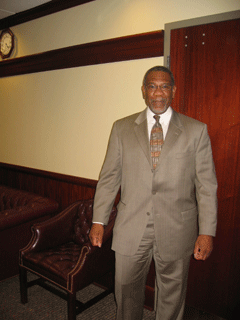
S. Gregory Baker, Director of Community Relations at the Cincinnati Police Department, says officers on duty can’t tell if someone has been exposed to lead, even if it may be partially causing them to commit violent acts of crime.
(photo: Ashley Ahearn)
AHEARN: Of the 250 people in the Cincinnati Lead Study Laquisha takes part in, nine have been killed in violent crime. To put that in perspective, this group is 650 times more likely to die in violent crime than the average American.
[SOUND IN CHURCH]
AHEARN: Sitting in a pew after the service at Christ Emmanuel Church, Councilmember Cecil Thomas says that from his perspective, homicide and lead exposure seem to go hand in hand. But there’s something else in the mix. It’s no surprise to him that less than half of the study participants finished high school.
THOMAS: Eighty percent of individuals that committed homicides did not finish high school and 75 percent of the victims had not finished high school so there was a direct link between the education and violence. Then you go back to the question of, "well why is that young man not finishing school. Has the lead poisoning affected his ability to learn?" So when we start looking at lead poisoning yes we are looking at maybe one of the causative factors to violence in our city.
AHEARN: Lead exposure levels have gone down in Americans of all races, but African American children are still twice as likely as white children to suffer from lead poisoning, thanks to housing patterns and poor nutrition. And with statistics showing black men as likely to go to jail as to go to college, this latest research linking violent crime and lead raises key questions for society.
There are many factors behind violence—home life, education, easy access to drugs and weapons… But a growing body of scientific evidence suggests lead also belongs on that list. Dr. Kim Dietrich of the University of Cincinnati likes to say that lead may not be the “gun,” so to speak, but it appears to be one factor that’s helping to pull the trigger.
For Living on Earth, I’m Ashley Ahearn in Cincinnati, Ohio.
Related links:
- Kim Dietrich’s study “Associations of Prenatal and Childhood Blood Level Concentrations with Criminal Arrests in Early Adulthood.”
- Kim Cecil’s study: “Decreased Brain Volume in Adults with Childhood Lead Exposure.”
- Cincinnati Children’s Environmental Health Center:
CURWOOD: The old man and the storm – how an indomitable 80-year old rebuilt his home after Hurricane Katrina. Stay tuned to Living on Earth.
ANNOUNCER: Support for the environmental health desk at Living on Earth comes from the Cedar Tree Foundation. Support also comes from the Richard and Rhoda Goldman fund for coverage of population and the environment. And from Gilman Ordway, for coverage of conservation and environmental change. This is Living on Earth on PRI, Public Radio International.
The Good Book’s Green Message

The Green Bible is published by Harper Collins Publishers (Courtesy of Harper Collins)
CURWOOD: It's Living on Earth, I'm Steve Curwood. It may not strike you as the typical best-seller – but the Christian Bible is the best selling book since Gutenberg first reproduced it in print in 1455.
The Bible has been translated into 2400 different languages, and now there’s even a green version. The Green Bible is printed on recycled paper with soy-based ink. More than 1000 of the passages that reference the earth or environment are highlighted in green.
The edition includes essays by theological leaders such as the late Pope John Paul II and Archbishop Desmond Tutu.
But perhaps the most accessible introduction to this Green Bible comes from University of Wisconsin biologist and evangelical apostle Calvin DeWitt. His essay is entitled “Reading the Bible Through a Green Lens.” God, says Professor DeWitt, calls on us to care for his creation.
DEWITT: The first reference to be fruitful and multiply is in Genesis 1:22 “Be fruitful and multiply and fill the skies and fill the seas.” And it’s a blessing of fruitfulness to the birds and the fish and by implication to the rest of the creatures of creation. And then in Genesis 1:28 that blessing is also given to human beings. Then Genesis 2 comes by and says "now you serve this creation, you serve the Garden." You know as in any book, you don’t stop at reading the first few paragraphs or the first chapter. If you look at Genesis 2:15 which is that great passage on service of creation and keeping creation, you can get from that our current idea of “con-service” or conservation.
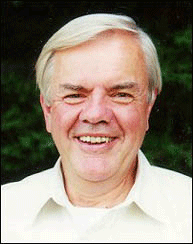
Calvin DeWitt is a professor of Environmental Studies at the Nelson Institute at the University of Wisconsin, Madison and Co-founder, International Evangelical Environmental Network.
CURWOOD: It’s really fascinating to look at the Bible and its references to the earth and to the environment, and even around such core questions as original sin. Now we human beings get tossed out of the Garden of Eden after committing the sin which involves, I guess, an environmental impropriety, having that apple.
DEWITT: Yeah. The story here is that human beings decide not to live within the limits of the Garden. Of course, that is not only apparent then but it is also apparent in our present day. Living within limits, even when those limits are designed to preserve yourself and to preserve the creatures and whole of creation is something that often is rebelled against by human beings. And certainly that was the case with the first human beings.
CURWOOD: Later in the book of Genesis, God commands Noah to build an ark and take a pair that is male and female of every animal into that ark while he floods the earth to destroy life on earth. So, in terms of the environmental perspective, what’s the moral of that story?
DEWITT: First of all, it’s the world’s first Endangered Species Act. What the passage tells us, is that the lineages of the various living creatures has to be conserved. Of course, I as an ecological scientist, also hold that strictly from a scientific perspective, and that is if we destroy the very system that sustains us, we destroy ourselves.
CURWOOD: Looking further here at the opening of the Bible in the early chapters, we come across the principle of the Sabbath. Now, this is not just about a day of rest for people; it’s a time of rest for the earth as well, is that right?

The Green Bible is published by Harper Collins Publishers (Courtesy of Harper Collins)
DEWITT: Yeah, it’s quite right. What we know is when we give rest to ourselves, to the creatures under our care, to our land and to what we call natural resources, that’s really also beneficial to them for sustaining them over the very long run. And that’s the practical result of keeping the Sabbath.
CURWOOD: Calvin DeWitt, what do you say to people who say that they are religious, but they drive gas guzzlers, they don’t recycle and, in fact, are pretty poor environmental stewards?
DEWITT: Well, if the people that are doing this are very, very strict in terms of their interpretation of the scriptures, then I will bring to light for them Revelation 11:18, that those who destroy the earth, will be destroyed. That, of course, can be very effective, if you take every verse very seriously. We can use the example of Jesus who is a person who takes on the form of a servant, the life of a servant, and serves, does not accumulate, but simply pursues justice, love, care for the poor, care for the land, and who invites us to behold the lilies of the field and the birds of the air.
CURWOOD: Calvin DeWitt wrote an essay in “The Green Bible.” He’s a professor of environmental studies at the University of Wisconsin in Madison. And also president of the Academy of Evangelical Scientists and Ethicists. Thanks so much Professor DeWitt.
DEWITT: You’re so welcome.
Related link:
The Green Bible
The Old Man and the Storm

Herbert Gettridge was 82 years old when he began rebuilding his home after Hurricane Katrina.
CURWOOD: On January sixth PBS will premier a documentary about the Gettridge family of the Lower Ninth Ward of New Orleans and how they struggled to rebuild their lives and their homes after Hurricane Katrina.
The family patriarch, 82-year old Herbert Gettridge, made it his mission to recreate the home he’d originally crafted more than 50 years earlier. Officials said the area was uninhabitable but Mr. Gettridge didn’t care.
GETTRIDGE (FROM DOCUMENTARY): I don’t need no electricity. My grandfather was a Choctaw Indian, man. I can make it with a flashlight. We got water - I got water. That’s all I need. And if I didn’t have water, guess what, when it’d rain, I’d catch what I can. And what I couldn’t catch, I’d do without. But I’m making it. I ain’t going no place, man. I’m going to stay right here. This is it, this is my home and this is where I’ll be.
CURWOOD: June Cross is an associate professor of journalism at Columbia University’s Graduate School of Journalism. She spent 18 months with the Gettridge family and produced the new film, “The Old Man and the Storm.”
She joins me from New York to talk about what made Mr. Gettridge so determined to rebuild. Welcome June.
CROSS: Thank you for having me, Steve.
CURWOOD: So in the wake of Hurricane Katrina, there were what a half a million families displaced? When you first went to the Lower Ninth Ward neighborhood six months after the storm, you say the only person you found there was Mr. Gettridge. What made him different? Why do you think he was so determined to rebuild?

June Cross is a film maker and professor of journalism at the Columbia Graduate
School of Journalism. (Courtesy of Frontline)
CROSS: In the first place it was the only house that still had four walls that were standing in that neighborhood. So it really could be rescued. I mean he literally just needed to gut it. All the rest of the homes had either pancaked or been washed away. You know, I think his attitude was, well, the house withstood the water. I’ll be damned if I’m gonna just walk away from it. I worked too hard to get this. He has worked since the time he was seven years old, dropped out of school during the Depression. And had learned to work with his hands. He was a master plasterer.
CURWOOD: Now how long had he lived there with his wife?
CROSS: Better part of 60 years. They bought the land in 1952. And he began – he had built the house originally from scratch himself, as he says with pennies from my pocket. You know, he had a couple of dollars this week, he’d, you know, buy the frame for the window. He has a couple of pennies the next week, he’d buy the screws so he could attach the doors. He had recycled parts from other buildings that had fallen down in New Orleans or that he was working on, because he worked on construction sites. You know, this was literally his creation. So there was nothing in his body that was going to allow him to walk away from that house.
CURWOOD: He’s from New Orleans. How far back did his family go?
CROSS: Five generations. They have stories about how the first ancestor came over from Ethiopia, some time in the early 1800s. And they had literally worked the land ever since. There was an old plantation called the McCarty Plantation - was actually the largest plantation in New Orleans at the time. It grew cotton and rice. And parts of that plantation were actually in the Lower Ninth Ward. So it’s possible that Mr. Gettridge owned the house on land that his ancestors had once worked as slaves.
CURWOOD: Let’s listen to another piece of tape, June. Here Mr. Gettridge is talking about life since the storm and how it’s changed his life and his family.
GETTRIDGE (IN DOCUMENTARY): It’s altogether a different life from before the storm. I’m here by myself almost day and night. I miss the kids; I miss the grandchildren. I miss a lot of stuff. Every day actions in this household we used to have. Kids playing in the yard, kids sitting on looking at the television, shooting video games and stuff like that. I miss all that. I have 36 grandchildren and of them 36 grandchildren, I bet you 26 of them be here in a week’s time. Ain’t a month passed that they all don’t pass by. Hi Grandma. Hi Grandpa.
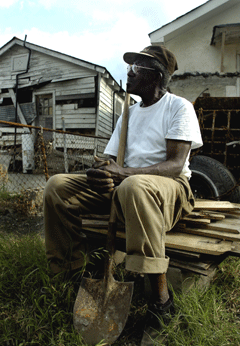
Herbert Gettridge was 82 years old when he began rebuilding his home after
Hurricane
CROSS: New Orleans more than any other city in the United States has families that go back at least four generations who are native to that place. It’s not a city that people leave. Families that have 200 or 300 people, who all live within a fifteen-minute drive from each other and still all get together for holidays and celebrate things. It’s a sense of community and belonging that I don’t think those of us who live anywhere else can really imagine.
CURWOOD: A large part of the struggle that you portray here is trying to get the federal and state money that’s been promised to help Mr. Gettridge and the others rebuild. Can you tell me about that?
CROSS: Oh boy. A year after Katrina none of the money that had been promised to individual homeowners had yet reached anybody. And it was just a very complicated sort of set up. You know, you wake up on Monday, and, you know, there’s no money. On Tuesday they say the money is coming. On Wednesday, they hand you sixty pages of paperwork to fill out. On Thursday, they say, “Oh, remember the papers we gave you yesterday, never mind, we made them up again, so we’re gonna give you thirty more pages.” And on Friday there’s something else. I mean it was –it’s just been like this. It’s so difficult to convey in a film.
CURWOOD: And all along, Mr. Gettridge is doing what?
CROSS: Mr. Gettridge was basically trying to get the house together so that he could bring his wife home. Lydia Gettridge, he’d married her when he was fifteen and she was fourteen. And she was up in Madison because she has congestive heart failure and diabetes and just wasn’t – nobody felt comfortable bringing her back to a city where there really was no hospital, no ambulance service or anything. And so she finally came home just before July fourth of 2007. A year and a half after the flood – yeah.
CURWOOD: And the house was done?
CROSS: The house was done. And she’s been there – actually, you know, she was beginning to go down hill in Madison. And every time I call down there now, she sounds just as chipper as she once used to be. She’d never really spent any time anywhere else but New Orleans. So it was really important for her to come back. And so, therefore, really important to him being a good husband (laughs) to make sure that she was able to get back.
CURWOOD: By the end of your film, Mr. Gettridge has rebuilt his home. His wife Lydia comes to join him in New Orleans, and you have a scene where some of his children and grandchildren are there at the return, but this is a bittersweet scene to me. And in the film you ask him if he had to do it all over again, would he? And this is how he responds…
GETTRIDGE (IN DOCUMENTARY): I’m kinda skeptical about that now. Once upon a time I could answer that question in a split second for you. I can’t do that now.
CROSS: He’s a man of incredible determination and incredibly stubborn. He’s been worn down. You know, there’s just so much you can do at 82 to start over again.
CURWOOD: June Cross’s latest film “The Old Man and the Storm” will be shown on the Frontline series beginning January sixth. Thank you so much, June.
CROSS: Thank you, Steve.
Related link:
To learn more about the film and see a trailer click here
[MUSIC: Terence Blanchard “Wading Through” from A Tale Of God’s Will (A Requiem For Katrina) (Blue Note Records 2007)]
Melting at the Top of the World
CURWOOD: Nowhere is climate disruption more dramatically apparent than on the roof of the world – where some experts predict Himalayan glaciers may be gone in as few as 40 years.
The snows of the Himalayas feed the headwaters of the Yellow, Yangtze, Ganges and Mekong Rivers and provide drinking water for billions throughout Asia.
Now local residents in Nepal who depend on tourists and climbers are starting to speak out about the dangers and demanding action – among them Dawa Stephen Sherpa, who runs a trekking company in Kathmandu. He spoke to us by phone from his expedition office about what action he’s taking, and his worries.
SHERPA: The Himalayas are the water towers of Asia. We all live in the same building and we have this big water tank on top of our house and when that water runs out we’re all gonna suffer. It’s not just gonna be the people who live near the mountains. Now when we’re talking about one, well, one and a half billion people – it doesn’t look very good. I mean, even now, if you look at the region, there’s a lot of tensions between the nations, you know, especially between Pakistan and India. Now when people don’t have access to fresh water, they may see access to fresh water on the other side of the border, so we’re looking at maybe mass migration, you know, heightened conflict. And it’s just a very, very bleak picture.
CURWOOD: In 2008, Dawa Steven you organized what you called an “eco expedition” up Mount Everest. What were you hoping to accomplish with that?
SHERPA: My first aim was to get on top of the world and talk to people about the impact of what climate change is doing to our mountains. You don’t get a higher platform I suppose.
[LAUGHING]
SHERPA: I made sure that I brought down everything I took up. There’s a lot of garbage from previous expeditions up there, you know. Rather than organize an expedition solely for climbing, what I did was I looked at – looked at what’s already available and - a lot of Sherpas going up the mountain carrying big loads, you know, like tents and sleeping bags, but when they come down, they come down empty. So what I did was I approached them and said hey, look, bring down any garbage that you see on the way and I’ll be happy to give you money for it, I’ll pay you by the kilo. And by the end of the season, I had 965 kilos of garbage, and we made the mountain a ton cleaner. We bring everything down that we’ve taken up – including poop.
CURWOOD: Tell me, what’s the problem with now – I don’t want to be too graphic here – but, what’s the problem now with human poop on the side of Mount Everest?
SHERPA: Nobody wants to talk about it. Nobody wants to clean it, right? We know that over time it will decompose – and that’s under normal circumstances. But on the mountain, it doesn’t, because it’s freezing conditions there. If I pitch my tent, over a period of a couple of weeks when the ice starts melting under you, poop starts coming up and you’re seeing you’re surrounded in human waste and in poop. And, of course, there’s some pretty nasty stories as well of climbers who have melted ice only to look in and find some very unsavory things in there. And, of course, all the water that come in the rivers, they all come from the mountains, and so if we have poo on our glaciers (laughs) then, of course, that’s going to come down into our water system – not the best in terms of health wise.
I used what are called Restop bags; they’re quite popular in America. And I was field testing them to see if I can use them to bring down human waste. They were very, very successful. As a climber, we didn’t feel guilty when we went to the bathroom on the mountain. And for us, Everest is a holy mountain, she’s called Chomolungma, Mother Goddess of the World. And to be actually going to the toilet on her would not be very nice. So when we were cleaning up the mountain it was great, you know, it felt really good.
CURWOOD: Now, you’ve had some interesting innovations in your work there and trying to clean things up. Tell me about the special solar cooker that you used to boil your water up there.
SHERPA: I was using what’s called a parabolic solar cooker. Basically how it works is it’s an inverted magnifying glass of sorts. It’s like a mirror that is reflecting light into one central position. And so in that central position, you put a pot, which you have painted black which absorbs all the heat. So within thirty-five minutes I was boiling ten liters of water – out of nothing. It was so successful that all the other sherpas from around the camps, other camps, came around the figure out, you know, to see what this thing was - this shiny thing that was boiling water. It cost less than $100. If you were cooking on kerosene or on gas, it will pay you back that money within a couple of months.
CURWOOD: So as you look at the projections, what sense do you have that your mountains might be doomed? What sense of hope do you have?
SHERPA: It’s something very emotional, something that I wish I could turn – you know, turn round, that I wish I could stop somehow, but…. I mean, that’s not realistic. I’m only one person. But I do believe that one person can make a difference. Climbing mountains in not difficult. Convincing people that they are significant, that they can do something about it, that’s the most difficult thing for me.
CURWOOD: Dawa Steven Sherpa is the managing director of Asian Trekking in Kathmandu, Nepal. Thank you so much.
SHERPA: Thank you, Steve.
CURWOOD: By the way, how do you say Happy New Year in Nepal.
SHERPA: In Nepal we say – okay, are you ready for this?
CURWOOD: I am.
SHERPA: Nayãã barsako subhakaamanaa
CURWOOD: Nayãã barsako subhakaamanaa
SHERPA: That’s it. Nayãã barsako subhakaamanaa.
CURWOOD: Happy New Year.
SHERPA: Happy New Year, Steve.
Related links:
- International Centre for Integrated Mountain Development on climate change:
- Check out videos of the trek here
[MUSIC: A Setting Sun “Garmonbozia” from Empty Sound (Moongadget Records 2008)]
CURWOOD: Living on Earth is produced by the World Media Foundation. Our crew includes Ashley Ahearn, Bobby Bascomb, Eileen Bolinsky, Bruce Gellerman, Ingrid Lobet, Helen Palmer, Mitra Taj and Jeff Young, with help from Sarah Calkins and Marilyn Govoni.
And this week we bid a fond farewell to our interns Sandra Larson and Jessie Martin. Jeff Turton is our technical director. Alison Lirish Dean composed our themes.
You can find us anytime at loe.org.
I’m Steve Curwood. Thanks for listening.
ANNOUNCER1: Funding for Living on Earth comes from the National Science Foundation, supporting coverage of emerging science, and Stonyfield Farm: organic yogurt and smoothies. Stonyfield pays its farmers not to use artificial growth hormones on their cows. Details at stonyfield.com.
Support also comes from you, our listeners, the Ford Foundation, the Town Creek Foundation, the Oak Foundation, supporting coverage of climate change and marine issues; The Bill and Melinda Gates Foundation, dedicated to the idea that all people deserve the chance to live a healthy productive life. Information at gatesfoundation.org; and Pax World Mutual Funds: socially and environmentally sustainable investing. Pax World: for tomorrow. On the web at paxworld.com.
Living on Earth wants to hear from you!
Living on Earth
62 Calef Highway, Suite 212
Lee, NH 03861
Telephone: 617-287-4121
E-mail: comments@loe.org
Newsletter [Click here]
Donate to Living on Earth!
Living on Earth is an independent media program and relies entirely on contributions from listeners and institutions supporting public service. Please donate now to preserve an independent environmental voice.
NewsletterLiving on Earth offers a weekly delivery of the show's rundown to your mailbox. Sign up for our newsletter today!
 Sailors For The Sea: Be the change you want to sea.
Sailors For The Sea: Be the change you want to sea.
 The Grantham Foundation for the Protection of the Environment: Committed to protecting and improving the health of the global environment.
The Grantham Foundation for the Protection of the Environment: Committed to protecting and improving the health of the global environment.
 Contribute to Living on Earth and receive, as our gift to you, an archival print of one of Mark Seth Lender's extraordinary wildlife photographs. Follow the link to see Mark's current collection of photographs.
Contribute to Living on Earth and receive, as our gift to you, an archival print of one of Mark Seth Lender's extraordinary wildlife photographs. Follow the link to see Mark's current collection of photographs.
 Buy a signed copy of Mark Seth Lender's book Smeagull the Seagull & support Living on Earth
Buy a signed copy of Mark Seth Lender's book Smeagull the Seagull & support Living on Earth

